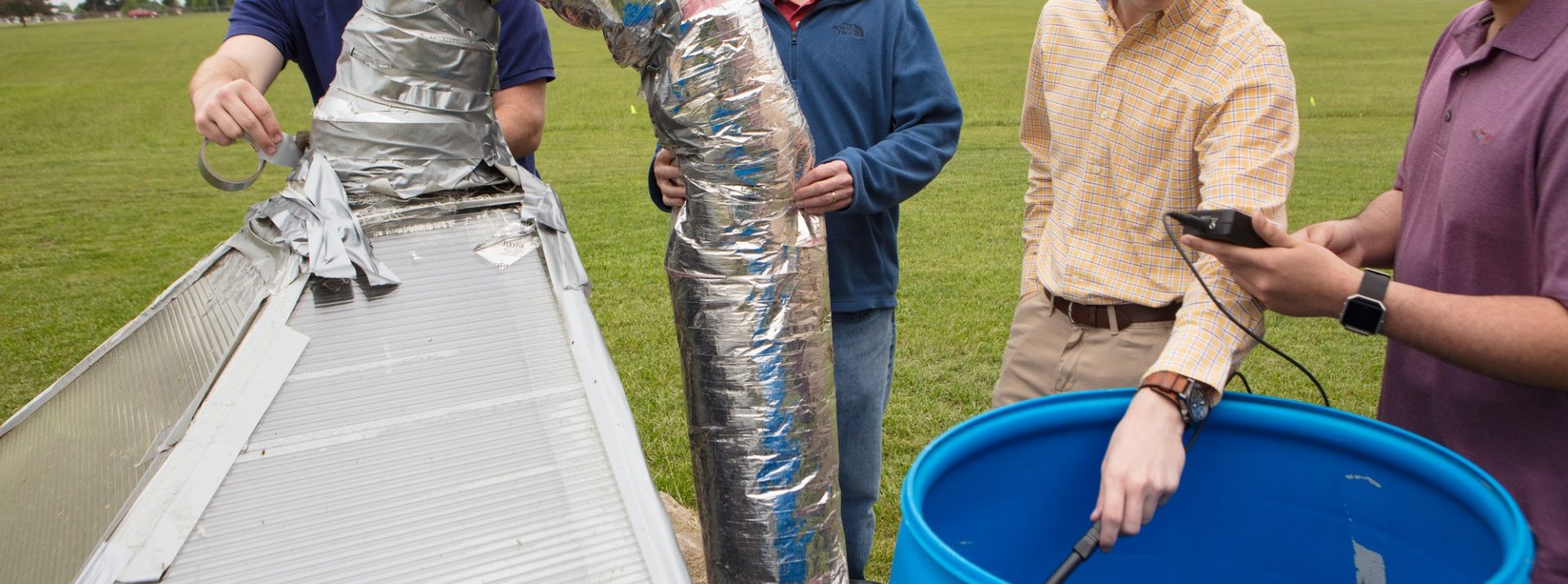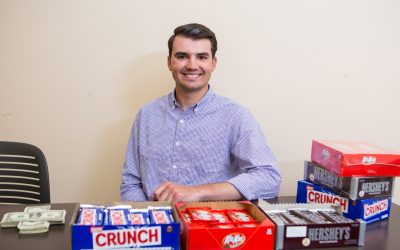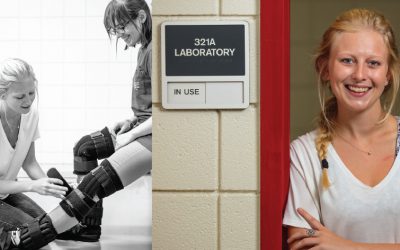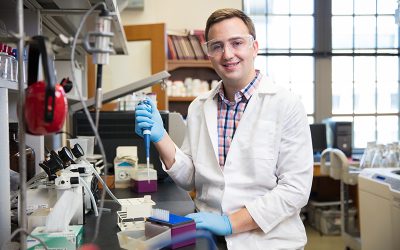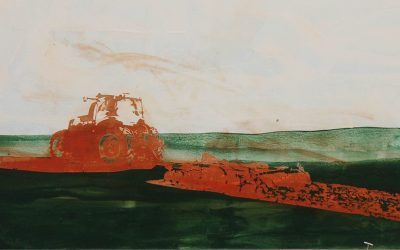
Garret Gardenhire, Kevin Le and Matt Annis monitor their solar-powered food dehydrator, designed to combat food insecurity in developing countries.
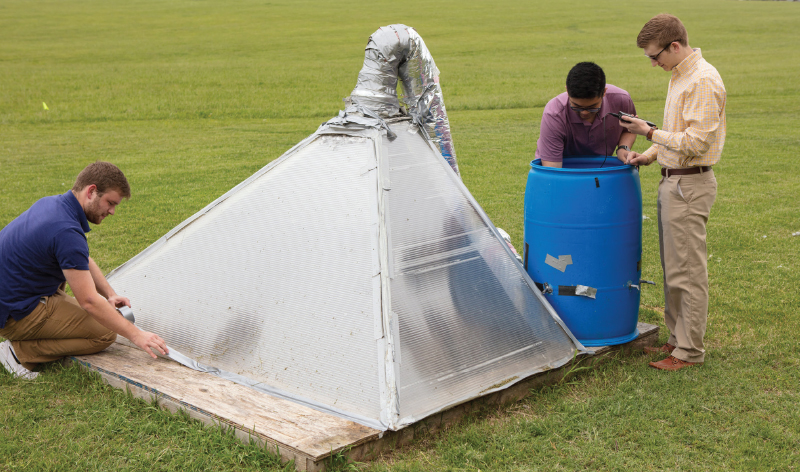
Freshmen honors engineering students Garret Gardenhire, Kevin Le and Matt Annis inherited a simple machine and a big idea: develop an inexpensive, efficient solar-powered food dehydrator to combat food insecurity in developing countries. The idea is not new – subsistence farmers spread wet grain on stone slabs to dry, but the grain is susceptible to mold, germination and theft. Other products on the grain-drying market tend towards high-cost, high-output systems that require both gas and electricity to operate.
The team’s prototype, nestled in a verdant field next to the biological engineering design studio north of campus, consists of a solar pyramid constructed from greenhouse plastic over black sheet metal, a duct, a drying container and “about 30 percent duct tape!” jokes Matt Annis, a civil engineering major. All that it needs to do the job is a sunny day.
Other engineering students designed and built the prototype last year – this team was tasked with proving that it worked and developing a business plan. Their project’s emphasis on teamwork and entrepreneurship is key to the new “Innovation Track,” which provides another option to the traditional research project required for honors freshman engineering students.
“About 80 percent of our graduates go out and work as engineers,” said team mentor Scott Osborn, an associate professor of biological and agricultural engineering who co-founded BlueInGreen, a water treatment company that has contributed more than $18 million to Arkansas’ economy. “The idea was, can we create a track that exposes them to what they do as engineers – inventing things and creating solutions for problems – that’s also entrepreneurial? I started my own company, and I wasn’t prepared at all. I talked with them about investors, who want to know not just does it work, but how can I make money from it. You have to think that through.”
“We started with proof of concept – we had to make sure it worked,” Annis said. The engineering behind the solar-powered food dehydrator is pretty simple: the sun heats up the sheet metal, which warms the air trapped between the metal and greenhouse plastic. The hot air rises into the pipe and then flows into the drying container filled with grain. “We were able to reduce moisture content in the grain from 25 to 30 percent down to 12 percent,” said Garret Gardenhire, an Honors College Fellow and a double major in biological and mechanical engineering. “We were also hitting about 60 percent efficiency, better than a solar panel, which has only 25 to 30 percent efficiency,” added Kevin Le, an Honors College Fellow majoring in industrial engineering.
Their prototype cost $500 to build; the final product, which would include a drying shed, would run $4,500 – far more than a subsistence farmer could afford. Their solution: market to philanthropic organizations such as the Gates Foundation or Heifer International.
“The Gates Foundation spends $400,000 on agricultural development each year, and Heifer has $30 million cash on hand,” said Annis, who spent Spring Break researching market data that would justify production. The team ultimately developed a two-phase business model. In phase one, they would sell 1,000 units priced at $7,500 each to a non-governmental organization. “That would establish a foothold, develop connections, and generate $3 million in profit that we could use for the next phase, the development of a second-generation product,” Annis said.
The team envisions solar panels on a shed as the next step. “They can store energy, so the system works on cloudy and sunny days,” Le said. “We also expect solar panels to improve in efficiency during the time we’re marketing the first product.”
More Field Notes Stories
Capitalizing on Viral Videos
“There are a lot of YouTubers out there who are popular and using products spontaneously, which I believe is more powerful with Millennials.” Six students enter the Walton College Behavioral Business Research Lab, painted a soothing peach color to put them...
Growing Up and Growing Old: Developing Research Skills in the Aging Lab
Allen straps on a knee brace, designed to mimic the effects of arthritis on the joints; she hopes that her research will lead to a greater awareness of ageist attitudes.by Samantha Kirby “What?” I asked. “What?” My hearing was poor. I turned toward the speaker, but...
Double Duty for Future MD
As part of his biochemistry thesis, Will Pohlman developed a dye technique that may prove useful to pharmacological companies. Biochemistry and animal science proved to be the perfect double major for Sturgis Fellow Will Pohlman, who dreamed about a career...
Fashion for the 21st-Century Flower Child
“They’re incredible! Katie and Laura took a dream I had and made it happen – they’ve opening up a whole new area of research for our program.” The theme was “Futuristic Floral” and the student designers rose to the challenge: the models who strutted down the runways...
Big Picture Data
“Hannah has painted something that everyone can respond to on a personal level, that offers people a way into a place to see it differently.” Rain or shine, at 7 a.m. every Tuesday for five months honors landscape architecture major Hannah Moll showed up, camera in...
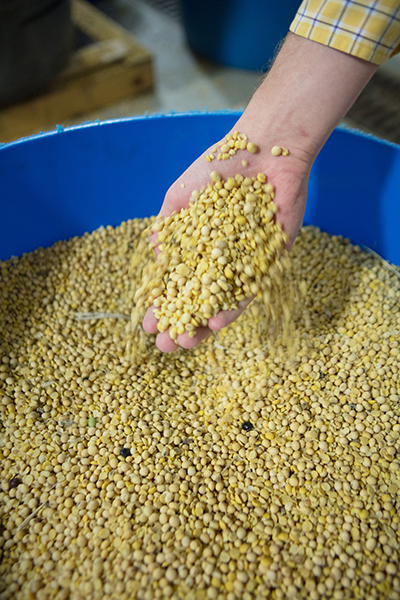
The prototype had problems – rain and clouds brought production to a standstill, and the unit was plagued with hot air coming out of the intake, as there were no fans to pull air through. Ultimately, the team concluded that the business plan was solid, but the prototype was not viable. “We need to improve efficiency and/or reduce costs – both would be prime,” Annis said. All were unanimous on the value of taking on a hands-on project their freshman year, making connections, and getting a preview on the senior year design project required for all engineering students.
Osborn praised their teamwork: “They took a concept, showed it could work, and expanded their vision out into two-, five- and ten-year plans.” He’s also pleased with the new innovation track as a motivation for future learning. “It’s ‘just in time’ education, instead of ‘just in case,’” he said. The team won Best Poster Presentation for Innovation at the 2017 Honors Engineering Symposium.
“It’s ‘just in time’ education, instead of ‘just in case.”
